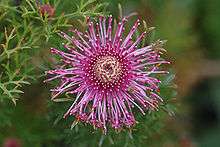Isopogon formosus
| Isopogon formosus | |
|---|---|
 | |
| Scientific classification | |
| Kingdom: | Plantae |
| (unranked): | Angiosperms |
| (unranked): | Eudicots |
| Order: | Proteales |
| Family: | Proteaceae |
| Genus: | Isopogon |
| Species: | I. formosus |
| Binomial name | |
| Isopogon formosus R.Br. | |
| Synonyms | |
|
Atylus formosus (R.Br.) Kuntze | |
Isopogon formosus or Rose Cone Flower is a shrub that is endemic to areas near Albany and Esperance in Western Australia. It occurs naturally in heathland and woodland areas.
Description
It has an erect or bushy form and is usually between 1.5 and 2 metres high. The pink flowers appear from mid winter to early summer. Rounded "drumsticks" containing the seeds appear later, formed from the old flower parts.The plants leaves are divided, narrow, terete and about 5 cm long.
Taxonomy
It was first described by Robert Brown in 1810.[1] In 1891, German botanist Otto Kuntze published Revisio generum plantarum, his response to what he perceived as a lack of method in existing nomenclatural practice.[2] Because Isopogon was based on Isopogon anemonifolius,[3] and that species had already been placed by Richard Salisbury in the segregate genus Atylus in 1807,[4] Kuntze revived the latter genus on the grounds of priority, and made the new combination Atylus formosus for this species.[5] However, Kuntze's revisionary program was not accepted by the majority of botanists.[2] Ultimately, the genus Isopogon was nomenclaturally conserved over Atylus by the International Botanical Congress of 1905.[6]
Cultivation
Isopogon formosus requires excellent drainage and full sun. It will not tolerate long periods of dryness or heavy frost.
References
- ↑ Brown, Robert (1810). "On the Proteaceae of Jussieu". Transactions of the Linnaean Society. 10: 72.
- 1 2 Erickson, Robert F. "Kuntze, Otto (1843–1907)". Botanicus.org. Retrieved 28 November 2015.
- ↑ Knight, Joseph (1809). On the Cultivation of the Plants Belonging to the Natural Order of Proteeae. London, United Kingdom: W. Savage. p. 94.
- ↑ Hooker, William (1805). The Paradisus Londinensis. 1. London, United Kingdom: D. N. Shury.
- ↑ Kuntze, Otto (1891). Revisio generum plantarum:vascularium omnium atque cellularium multarum secundum leges nomenclaturae internationales cum enumeratione plantarum exoticarum in itinere mundi collectarum. Leipzig, Germany: A. Felix. p. 578.
- ↑ "Congrès international de Botanique de Vienne". Bulletin de la Société botanique de France. 52: LIII. 1905.
External links
- Australian National Botanic Gardens: Isopogon formosus
- "Isopogon formosus". FloraBase. Western Australian Government Department of Parks and Wildlife.
